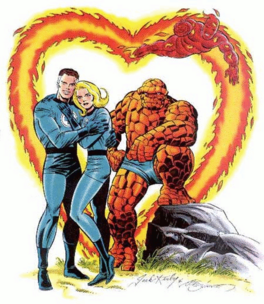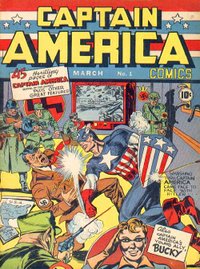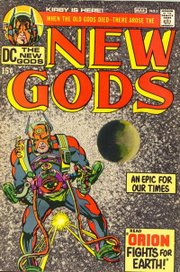Jack Kirby
Jack Kirby (August 28, 1917–February 6, 1994) was one of the most influential, recognizable, and prolific artists in United States comic books. Born Jacob Kurtzberg to Jewish Austrian parents in New York City, he was also a comic book writer and editor. more...
His most common nickname is The King.
Early life
Jacob Kurtzberg grew up on Suffolk Street in New York's Lower East Side, attending elementary school at P.S. 20. His father, a garment-factory worker, was a Conservative Jew, and Jacob attended Hebrew school. Jacob's one sibling, a brother five years younger, predeceased him. After a rough-and-tumble childhood with much fighting among the kind of kid gangs he would render more heroically in his future comics, Kirby enrolled at the Pratt Institute in Brooklyn, at what he said was age 14, leaving after a week. "I wasn't the kind of student that Pratt was looking for. They wanted people who would work on something forever. I didn't want to work on any project forever. I intended to get things done."1
Essentially self-taught, Kirby cited among his influences the comic strip artists Alex Raymond and Milt Caniff.
The Golden Age of Comics
Kirby joined the Lincoln Newspaper Syndicate in 1936, working there on newspaper comic strips and on single-panel advice cartoons such as Your Health Comes First (under the pseudonym "Jack Curtiss"). Kirby remained until the firm went out of business in 1938, then worked for the movie animation company Fleischer Studios as an "in-betweener", an artist who fills in the action between major-movement frames, on Popeye cartoons. "I went from Lincoln to Fleischer," he recalled. "From Fleischer I had to get out in a hurry because I couldn't take that kind of thing," describing it as "a factory in a sense, like my father's factory. They were manufacturing pictures."2
Around this time, "I began to see the first comic books appear."2 The first American comic books were reprints of newspaper comic strips; soon, these tabloid-size, 10-inch by 15-inch "comic books" began to include original material in comic-strip form. Kirby began writing and drawing such material for the comic book packager Eisner & Iger, one of a handful of firms creating comics on demand for publishers. Through that company, Kirby did what he remembers as his first comic book work, for Wild Boy Magazine.3 This was followed by such strips as the science fiction adventure The Diary of Dr. Hayward (under the pseudonym "Curt Davis"), the modern-West crimefighter strip Wilton of the West (as "Fred Sande"), the swashbuckler strip "The Count of Monte Cristo" (as Jack Curtiss), and the humor strips Abdul Jones (as "Ted Grey)" and Socko the Seadog (as "Teddy"), for Jumbo Comics and other Eisner-Iger clients.
Kirby moved on to comic book publisher and newspaper syndicator Fox Feature Syndicate, earning a then quite-reasonable $15 a week salary. He began exploring superhero narrative with the comic strip The Blue Beetle (January–March 1940), starring a character created by Chuck Cuidera4 in Mystery Men Comics #1 under the pseudonym, "Charles Nicholas", which Kirby retained.
Simon & Kirby
During this time, Kirby met and began collaborating with cartoonist and Fox editor Joe Simon, who in addition to his staff work continued to freelance. Speaking at a 1998 San Diego ComicCon panel, Simon recounted the fateful meeting:
I had a suit and Jack thought that was really nice. He'd never seen a comic book artist with a suit before. The reason I had a suit was that my father was a tailor. Jack's father was a tailor too, but he made pants! Anyway, I was doing freelance work and I had a little office in New York about ten blocks from DC's and Fox's offices, and I was working on Blue Bolt for Funnies, Inc. So, of course, I loved Jack's work and the first time I saw it I couldn't believe what I was seeing. He asked if we could do some freelance work together. I was delighted and I took him over to my little office. We worked from the second issue of Blue Bolt...
and remained a team across the next two decades.
After leaving Fox and landing at pulp magazine publisher Martin Goodman's Timely Comics (the future Marvel), the new Simon & Kirby team created the seminal patriotic hero Captain America in 1941. Kirby's dynamic perspectives, groundbreaking use of centerspreads, cinematic techniques and exaggerated sense of action made the title an immediate hit and rewrote the rules for comic book art. Captain America Comics is credited with comics' first full-page panel.
Captain America became the first and largest of many hit characters the duo would produce. The Simon & Kirby name soon became synonymous with exciting superhero comics, and the two became industry stars whose readers followed them from title to title. A financial dispute with Goodman led to their decamping to National Publications, the primary precursor of DC Comics, after ten issues of Captain America. Given a lucrative contract at their new home, Simon & Kirby revamped The Sandman in Adventure Comics, and scored their next hits with the "kid gang" teams the Boy Commandos and the Newsboy Legion, and the superhero Manhunter.
Kirby married Rosalind "Roz" Goldstein (September 25, 1922–December 22, 1998) on May 23, 1942. That same year he changed his named legally from Jacob Kurtzberg to Jack Kirby. The couple was living in Brighton Beach, Brooklyn, when Kirby was drafted into the U.S. Army in the late autumn of 1943. Serving with the Third Army combat infantry, he landed in Normandy, on Omaha Beach, 10 days after D-Day.
As superhero comics waned in popularity after the end of World War II, Kirby and his partner began producing a variety of other genre stories. They are credited with the creation of the first romance title, Young Romance Comics. In addition, Kirby and Simon produced crime, horror, western and humor comics.
Read more at Wikipedia.org




